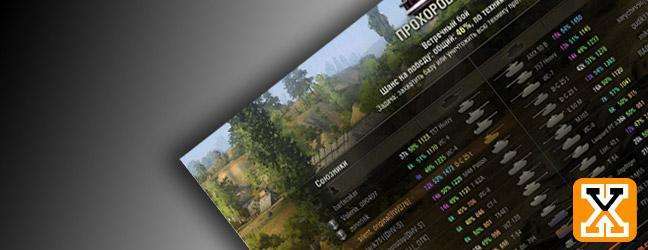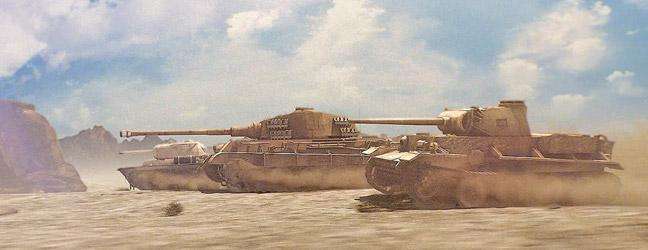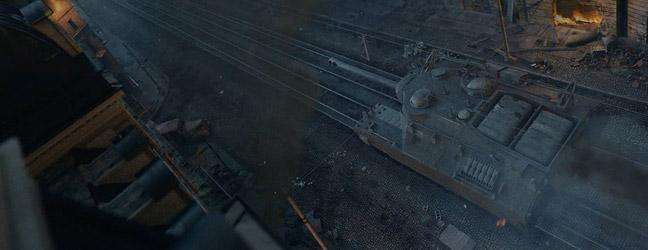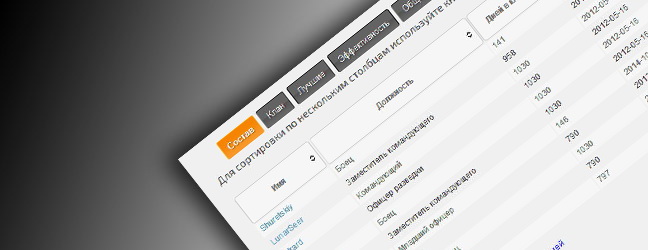The King of Tigers
Дата: 18.02.2011 17:19:10
admin: 
65 years have passed since WWII was over but tank fans from all over the world are still debate on the controversial question – “Which vehicle was the best WWII tank?” And after this question we will hear various opinions: Tiger II (King Tiger), Panther (who was considered to be a heavy tank according to the Allies classification, but was a medium tank in German army during WWII), T-34 (legendary Soviet tank), IS-2 (heavy Soviet tank), Pershing (one of the best American tanks of the last phase of WWII) or Sherman (the American working-horse).
The King Tiger (Tiger II) saga began at a meeting with Hitler on 26th of May 1941. At this meeting were represented all the key persons of Panzer development: Reichsminister für Bewaffung und Munition Dr Todt, Col. Phillips from Waffenamt, Lt.Col. von Wilke and Oberbaurat Kniepkamp from Wa Prüf 6, Reichsamtleiter Saur, and Prof. Dr Porsche. After reviewing the current status of and proposals for tank development, Hitler specified that the following additional measures were necessary:
- While Panzer with a 5 cm Kw.K. (tank gun) could still be employed, the spearhead consisting of about 20 heavy Panzers was to be immediately created for each panzer division (to penetrate enemy tanks; possess heavier armour; and attain a max speed of at last 40 km/h)
- To increase the firepower and penetration characteristics it was decided to mount 8.8 cm Kw.K. gun (this gun had originally been developed strictly for anti-aircraft purposes but had proven itself in an anti-tank role). The effectiveness of the existing 8.8 Kw.K. and its armor-piercing round were to be increased (to penetrate 100 mm thick armor plate at 1500 m range).
- Design and fabrication of both of the heavy Panzer prototypes (one by Prof. Dr Porsche and the other by the firm of Henschel and Sohn) were to be accelerated.
On 17th February 1943, Prof. Dr Porsche reported that three prototype Pz.Kpfw. Tiger P2s (VK 4502 (P)) with electrich drives and new suspension were being assembled in Nibelungenwerk. Prof. Dr Porsche also stated that as planned the subsequent production series vehicles would receive hydraulic drives, a new suspension, air-cooled 900 metric hp diesel motors, thicker armor and heavier armament. At this time, the production series was not expected to occur until far in the future.
But, unfortunately Prof. Dr Porsche influence decreased substantially in December 1943 and all the works on the project were stopped. As Dr Stiele von Heydekampf (general manager at Henschel) commented:
“Dr Porsche had been in disfavor for some time owing to the unsatisfactory performance of tanks of his design. The many changes he demanded, and the fact that when a new weapon was requested, he proposed a completely new and unorthodox design without regard to the use of existing production facilities or the past experience, were retarding production.”
So, the choice was made in favor of the Henschel project with his VK 4503 (H) chassis. The new hull design for the VK 4503 (H) consisted of sloping plates for increased protection. The front glacis plate was 150 mm at 50 degrees, front nose plate 100 mm at 50 degrees, superstructure side plates 80 mm at 25 degrees, hull side plates 80 mm at 0 degrees vertical, tail plate 80 mm at 30 degrees, deck plates 40 mm at 90 degrees horizontal, front belly plate 40 mm horizontal and rear belly plate 25 mm horizontal.
The drive train consisted of a high cperformance Maybach HL 230 P30, a 12-cylinder motor delivering 750 metric hp at 3000 rmp, through an 8-speed Maybach Olvar 40 12 16 B transmission on the Henshel L 801 double radius steering gear and final drives, designed to provide a maximum speed of 41.5 km/h.
On the VK 4503 (h) chassis were mounted three types of turrets:
- The ‘Porsche’ Turret (P2-Turm) – the original ‘Porsche’ Turret was purposefully designed in order to move the gun trunnions forward. Along with the sloping sides and roof, the rounded, 100 mm thick turret front presented a very difficult target for enemy gunners.
- Krupp Turret (H3-Turm) – The cancellation of the Tiger P2 production determined that on 7 Dec 1942 many components ordered for the ‘Porsche’ (P2-Turm) could be used without modification in the H3-Turm with strengthened front to 180 mm (what increased weight to 500 kg), the angle of the turret side was reduced from 30 to 21 degrees with 90 mm thickness, and the commanders cupola was relocated to a position 50 mm closer to the turret center.
- The new Serienturm (series turret) designed for the Tiger H3 had a 180 mm thick front plate, 80 mm sidewalls, and 40 mm roof. The gun mantle was specifically designed to be immune to attack or being jammed.
The first combat use of the Tiger II was by the 1st company of the Schwere Heers Panzer Abteilung 503 during the Battle of Normandy, opposing Operation Atlantic between Troarn and Demouville on 18 July 1944; losses were two from combat, plus the company commander's tank which became irrecoverably trapped after falling into a bomb crater made during Operation Goodwood.
The description of Battle near Caen from the Leutnant von Rosen’s from Schwere Heers Panzer Abteilung 503 Report on the operations of the 3’rd Company on 11 July 1944”
“I led the company to the front, established contact at the outskirts of the village. It was easy to make out several of the enemy tanks that were at a farmyard about two kilometers away.
The first tank had barely reached the northern outskirts of the village when it received heavy fire from enemy tanks. That resulted a brief halt, but short afterwards tanks shared: first platoon to the left, second to the right. During the maneuver the tanks took a significant number of hits. However, at that range they could not do us much harm.
All the maneuvers were automatic. One platoon secured and provided covering fire, the other moved forward in a single bound. Little more was to be seen of the enemy tanks, since the farm where they had taken position was then only a dark cloud of smoke.
The enemy infantry then withdrew with the aid of a smokescreen. As the smoke cleared somewhat, I spotted several enemy tanks. At that extremely short range, every round from our gun sent another Sherman up in flames. The crews bailed out of their yet undamaged tanks in terrified panic. We received no more fire and covered the final 200 meters in a single bound. We were in a farmstead and had regained the former main line of resistance. All of that had taken about thirty minutes.”
On the Eastern Front, it was first used on 12 August 1944 by the Schwere Heers Panzer Abteilung 501 (s.H.Pz.Abt. 501) resisting the Lvov–Sandomierz Offensive. It attacked the Soviet bridgehead over the Vistula River near Baranów Sandomierski. On the road to Oględów, three Tiger IIs were destroyed in an ambush by a few T-34-85s. Because these tanks suffered ammunition explosions which caused many crew fatalities, main gun rounds were no longer allowed to be stowed within the turret, reducing capacity to 68. Up to fourteen Tiger IIs of the 501st were lost in the area between 12 and 13 August to flanking ambushes by the Soviet T-34-85 and IS-2 tanks in inconvenient sandy terrain.
From after-action Report of Hauptmann Fromme”:
“ Experience has just confirmed that the Russians construct strong antitank defenses immideately behind their foremost units. The employment of American 9.2 cm and conical antitank guns (7.5 down to 5.7 cm) has, fortunately, only led to two total losses so far. Those weapons even penetrate the gun mantlet at ranges under 600 meters. Hits that penetrate the back of the turret cause explosion of the ammunition stored there and generally have resulted in total losses of the vehicles
In armor versus armor engagement, the 8.8 KwK 43 has proven effective in destroying all types of enemy armor, including the Stalin tank at ranges up to 1500 meters. T-34 and T-43 tanks could be knocked out in favorable firing conditions at ranges up to 3000 meters. Frequently, as in the West, the Russian tanks avoided combating Tigers or turned away after the first tank was knocked out. The same holds true for assault guns as for the Stalin tanks. Assault guns have not yet been knocked out at ranges greater than 1500 meters.
In summary, the Tiger II has proven itself in every way and is a weapon that the enemy fears. When the formation is used as a single, unified entity and is employed in accordnance with proper tactics, it always brings decisive success. However, most of the higher-level commands do not look out for the technical and tactical needs of a Tiger-Abteilung.”
On 15 October 1944 Tiger IIs of s.H.Pz.Abt. 503 played a crucial role during Operation Panzerfaust, supporting Otto Skorzeny's troops in taking the Hungarian capital of Budapest, which ensured that the country remained with the Axis until the end of the war. The 503rd then took part in the Battle of Debrecen. The 503rd remained in the Hungarian theater of operations for 166 days, during which it accounted for at least 121 Soviet tanks, 244 anti-tank guns and artillery pieces, five aircraft and a train. This was at the loss of 25 Tiger IIs; ten were knocked out by Soviet troops and burned out, two were sent back to Vienna for a factory overhaul, while thirteen were blown up by their crews for various reasons, usually to prevent them from falling into enemy hands. Kurt Knispel, the highest scoring tank ace of all time (162 enemy AFVs destroyed), also served with the 503rd, and was killed in action on 29 April 1945 in his Tiger II.
The Tiger II was also present at the Ardennes Offensive of December 1944, the Soviet Vistula–Oder and East Prussian Offensives in January 1945, the German Lake Balaton Offensive in Hungary in March 1945, the Battle of the Seelow Heights in April 1945, and finally the Battle of Berlin at the end of the war.
The Schwere SS Panzer Abteilung 503 (s.SS Pz.Abt. 503) claimed approximately 500 kills in the period from January to April 1945 on the Eastern Front for the loss of 45 Tiger IIs (most of which were abandoned and destroyed by their own crews after mechanical breakdowns or for lack of fuel).
Soviet wartime testing
During August 1944, a number of Tiger II tanks were captured by the Soviets near Sandomierz and were soon moved to their testing grounds at Kubinka. The Soviet team gave the opinion that the tests revealed the tanks to be severely defective; the transmission and suspension broke down very frequently and the engine was prone to overheating and consequential failure. Additionally, the Soviets opinion was of deficiencies in the armor after firing many anti-tank rounds at the same target. Not only did they report that the metal was of shoddy quality (a problem not particular to the Tiger II—as the war progressed, the Germans found it harder and harder to obtain the alloys needed for high-quality steel), but the welding was also, despite "careful workmanship", extremely poor. As a result, even when shells did not penetrate the armor, there was a large amount of spalling, and the armor plating cracked at the welds when struck by multiple heavy shells, rendering the tank inoperable.

65 years have passed since WWII was over but tank fans from all over the world are still debate on the controversial question – “Which vehicle was the best WWII tank?” And after this question we will hear various opinions: Tiger II (King Tiger), Panther (who was considered to be a heavy tank according to the Allies classification, but was a medium tank in German army during WWII), T-34 (legendary Soviet tank), IS-2 (heavy Soviet tank), Pershing (one of the best American tanks of the last phase of WWII) or Sherman (the American working-horse).
The King Tiger (Tiger II) saga began at a meeting with Hitler on 26th of May 1941. At this meeting were represented all the key persons of Panzer development: Reichsminister für Bewaffung und Munition Dr Todt, Col. Phillips from Waffenamt, Lt.Col. von Wilke and Oberbaurat Kniepkamp from Wa Prüf 6, Reichsamtleiter Saur, and Prof. Dr Porsche. After reviewing the current status of and proposals for tank development, Hitler specified that the following additional measures were necessary:
- While Panzer with a 5 cm Kw.K. (tank gun) could still be employed, the spearhead consisting of about 20 heavy Panzers was to be immediately created for each panzer division (to penetrate enemy tanks; possess heavier armour; and attain a max speed of at last 40 km/h)
- To increase the firepower and penetration characteristics it was decided to mount 8.8 cm Kw.K. gun (this gun had originally been developed strictly for anti-aircraft purposes but had proven itself in an anti-tank role). The effectiveness of the existing 8.8 Kw.K. and its armor-piercing round were to be increased (to penetrate 100 mm thick armor plate at 1500 m range).
- Design and fabrication of both of the heavy Panzer prototypes (one by Prof. Dr Porsche and the other by the firm of Henschel and Sohn) were to be accelerated.
On 17th February 1943, Prof. Dr Porsche reported that three prototype Pz.Kpfw. Tiger P2s (VK 4502 (P)) with electrich drives and new suspension were being assembled in Nibelungenwerk. Prof. Dr Porsche also stated that as planned the subsequent production series vehicles would receive hydraulic drives, a new suspension, air-cooled 900 metric hp diesel motors, thicker armor and heavier armament. At this time, the production series was not expected to occur until far in the future.
But, unfortunately Prof. Dr Porsche influence decreased substantially in December 1943 and all the works on the project were stopped. As Dr Stiele von Heydekampf (general manager at Henschel) commented:
“Dr Porsche had been in disfavor for some time owing to the unsatisfactory performance of tanks of his design. The many changes he demanded, and the fact that when a new weapon was requested, he proposed a completely new and unorthodox design without regard to the use of existing production facilities or the past experience, were retarding production.”
So, the choice was made in favor of the Henschel project with his VK 4503 (H) chassis. The new hull design for the VK 4503 (H) consisted of sloping plates for increased protection. The front glacis plate was 150 mm at 50 degrees, front nose plate 100 mm at 50 degrees, superstructure side plates 80 mm at 25 degrees, hull side plates 80 mm at 0 degrees vertical, tail plate 80 mm at 30 degrees, deck plates 40 mm at 90 degrees horizontal, front belly plate 40 mm horizontal and rear belly plate 25 mm horizontal.
The drive train consisted of a high cperformance Maybach HL 230 P30, a 12-cylinder motor delivering 750 metric hp at 3000 rmp, through an 8-speed Maybach Olvar 40 12 16 B transmission on the Henshel L 801 double radius steering gear and final drives, designed to provide a maximum speed of 41.5 km/h.
On the VK 4503 (h) chassis were mounted three types of turrets:
- The ‘Porsche’ Turret (P2-Turm) – the original ‘Porsche’ Turret was purposefully designed in order to move the gun trunnions forward. Along with the sloping sides and roof, the rounded, 100 mm thick turret front presented a very difficult target for enemy gunners.
- Krupp Turret (H3-Turm) – The cancellation of the Tiger P2 production determined that on 7 Dec 1942 many components ordered for the ‘Porsche’ (P2-Turm) could be used without modification in the H3-Turm with strengthened front to 180 mm (what increased weight to 500 kg), the angle of the turret side was reduced from 30 to 21 degrees with 90 mm thickness, and the commanders cupola was relocated to a position 50 mm closer to the turret center.
- The new Serienturm (series turret) designed for the Tiger H3 had a 180 mm thick front plate, 80 mm sidewalls, and 40 mm roof. The gun mantle was specifically designed to be immune to attack or being jammed.
The first combat use of the Tiger II was by the 1st company of the Schwere Heers Panzer Abteilung 503 during the Battle of Normandy, opposing Operation Atlantic between Troarn and Demouville on 18 July 1944; losses were two from combat, plus the company commander's tank which became irrecoverably trapped after falling into a bomb crater made during Operation Goodwood.
The description of Battle near Caen from the Leutnant von Rosen’s from Schwere Heers Panzer Abteilung 503 Report on the operations of the 3’rd Company on 11 July 1944”
“I led the company to the front, established contact at the outskirts of the village. It was easy to make out several of the enemy tanks that were at a farmyard about two kilometers away.
The first tank had barely reached the northern outskirts of the village when it received heavy fire from enemy tanks. That resulted a brief halt, but short afterwards tanks shared: first platoon to the left, second to the right. During the maneuver the tanks took a significant number of hits. However, at that range they could not do us much harm.
All the maneuvers were automatic. One platoon secured and provided covering fire, the other moved forward in a single bound. Little more was to be seen of the enemy tanks, since the farm where they had taken position was then only a dark cloud of smoke.
The enemy infantry then withdrew with the aid of a smokescreen. As the smoke cleared somewhat, I spotted several enemy tanks. At that extremely short range, every round from our gun sent another Sherman up in flames. The crews bailed out of their yet undamaged tanks in terrified panic. We received no more fire and covered the final 200 meters in a single bound. We were in a farmstead and had regained the former main line of resistance. All of that had taken about thirty minutes.”
On the Eastern Front, it was first used on 12 August 1944 by the Schwere Heers Panzer Abteilung 501 (s.H.Pz.Abt. 501) resisting the Lvov–Sandomierz Offensive. It attacked the Soviet bridgehead over the Vistula River near Baranów Sandomierski. On the road to Oględów, three Tiger IIs were destroyed in an ambush by a few T-34-85s. Because these tanks suffered ammunition explosions which caused many crew fatalities, main gun rounds were no longer allowed to be stowed within the turret, reducing capacity to 68. Up to fourteen Tiger IIs of the 501st were lost in the area between 12 and 13 August to flanking ambushes by the Soviet T-34-85 and IS-2 tanks in inconvenient sandy terrain.
From after-action Report of Hauptmann Fromme”:
“ Experience has just confirmed that the Russians construct strong antitank defenses immideately behind their foremost units. The employment of American 9.2 cm and conical antitank guns (7.5 down to 5.7 cm) has, fortunately, only led to two total losses so far. Those weapons even penetrate the gun mantlet at ranges under 600 meters. Hits that penetrate the back of the turret cause explosion of the ammunition stored there and generally have resulted in total losses of the vehicles
In armor versus armor engagement, the 8.8 KwK 43 has proven effective in destroying all types of enemy armor, including the Stalin tank at ranges up to 1500 meters. T-34 and T-43 tanks could be knocked out in favorable firing conditions at ranges up to 3000 meters. Frequently, as in the West, the Russian tanks avoided combating Tigers or turned away after the first tank was knocked out. The same holds true for assault guns as for the Stalin tanks. Assault guns have not yet been knocked out at ranges greater than 1500 meters.
In summary, the Tiger II has proven itself in every way and is a weapon that the enemy fears. When the formation is used as a single, unified entity and is employed in accordnance with proper tactics, it always brings decisive success. However, most of the higher-level commands do not look out for the technical and tactical needs of a Tiger-Abteilung.”
On 15 October 1944 Tiger IIs of s.H.Pz.Abt. 503 played a crucial role during Operation Panzerfaust, supporting Otto Skorzeny's troops in taking the Hungarian capital of Budapest, which ensured that the country remained with the Axis until the end of the war. The 503rd then took part in the Battle of Debrecen. The 503rd remained in the Hungarian theater of operations for 166 days, during which it accounted for at least 121 Soviet tanks, 244 anti-tank guns and artillery pieces, five aircraft and a train. This was at the loss of 25 Tiger IIs; ten were knocked out by Soviet troops and burned out, two were sent back to Vienna for a factory overhaul, while thirteen were blown up by their crews for various reasons, usually to prevent them from falling into enemy hands. Kurt Knispel, the highest scoring tank ace of all time (162 enemy AFVs destroyed), also served with the 503rd, and was killed in action on 29 April 1945 in his Tiger II.
The Tiger II was also present at the Ardennes Offensive of December 1944, the Soviet Vistula–Oder and East Prussian Offensives in January 1945, the German Lake Balaton Offensive in Hungary in March 1945, the Battle of the Seelow Heights in April 1945, and finally the Battle of Berlin at the end of the war.
The Schwere SS Panzer Abteilung 503 (s.SS Pz.Abt. 503) claimed approximately 500 kills in the period from January to April 1945 on the Eastern Front for the loss of 45 Tiger IIs (most of which were abandoned and destroyed by their own crews after mechanical breakdowns or for lack of fuel).
Soviet wartime testing
During August 1944, a number of Tiger II tanks were captured by the Soviets near Sandomierz and were soon moved to their testing grounds at Kubinka. The Soviet team gave the opinion that the tests revealed the tanks to be severely defective; the transmission and suspension broke down very frequently and the engine was prone to overheating and consequential failure. Additionally, the Soviets opinion was of deficiencies in the armor after firing many anti-tank rounds at the same target. Not only did they report that the metal was of shoddy quality (a problem not particular to the Tiger II—as the war progressed, the Germans found it harder and harder to obtain the alloys needed for high-quality steel), but the welding was also, despite "careful workmanship", extremely poor. As a result, even when shells did not penetrate the armor, there was a large amount of spalling, and the armor plating cracked at the welds when struck by multiple heavy shells, rendering the tank inoperable.
 News from the Front\Developers Blog\The King of Tigers
News from the Front\Developers Blog\The King of Tigers













